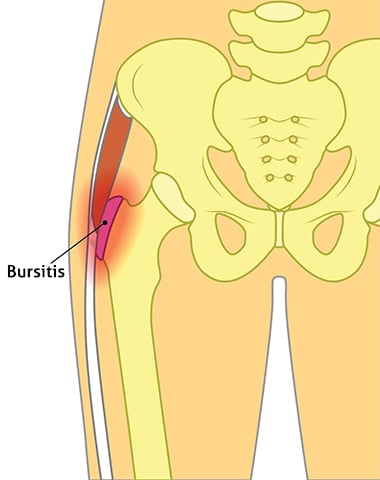What is Hip Bursitis?
 A common cause of hip pain, hip bursitis is the inflammation of the bursa (fluid-filled sacs that cushion the tendons, ligaments, and muscles). When the bursa becomes irritated or inflamed, it causes pain in the hip.
A common cause of hip pain, hip bursitis is the inflammation of the bursa (fluid-filled sacs that cushion the tendons, ligaments, and muscles). When the bursa becomes irritated or inflamed, it causes pain in the hip.
The hip has two major bursae (sacs). The trochanteric bursa which is located at the outside point of the hip ( called the greater trochanter). When this outside hip bursa gets inflamed, it is called trochanteric bursitis also know as greater trochanteric pain syndrome (GTPS). The other bursa (iliopsoas bursa) is on the inside of the hip area.
Symptoms of Hip Bursitis
Trochanteric Bursitis symptoms may start with pain and tenderness at the outside of the hip followed by swelling around the affected area. The first days, the pain might be felt as sharp, but it may become dull and achy as the days pass. The pain can get worse over time if left untreated and it can start radiating down the leg. Activities such as moving your hip, going down the stairs and getting up from a chair might become more difficult or painful.
Causes of Hip Bursitis
Although people of any age may get the trochanteric bursitis, it generally occurs in middle-aged or older people and it is mostly related to hip joint overuse or injury. Some of the most common causes of hip bursitis are:
- Bad posture (triggered by some spine problems such as scoliosis).
- Rheumatoid arthritis.
- Injury of the hip.
- Gout.
- Diabetes.
- Uneven leg lengths.
- Bone spurs on the hip.
- Previous hip surgery.
Treatment for Bursitis of the Hip
Treatment for bursitis always aims at reducing pain and inflammation while preserving mobility. Hip bursitis symptoms are commonly relieved by using the RICE method: rest, ice, compression, and elevation. Other treatment recommendations normally include non-steroidal anti-inflammatory medication, corticosteroid injections, and physical therapy.
Surgery may be recommended (rarely) if the bursa is beyond repair through conservative methods.
